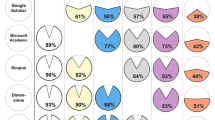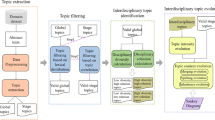Abstract
Exploring the topic hierarchy of a research field can help us better recognize its intellectual structure. This paper proposes a new method to automatically discover the topic hierarchy, in which the keyword network is constructed to represent topics and their relations, and then decomposed hierarchically into shells using the K-core decomposition method. Adjacent shells with similar morphology are merged into layers according to their density and clustering coefficient. In the keyword network of the digital library field in China, we discover four different layers. The basic layer contains 17 tightly-interconnected core concepts which form the knowledge base of the field. The middle layer contains 13 mediator concepts which are directly connected to technology concepts in the basic layer, showing the knowledge evolution of the field. The detail layer contains 65 concrete concepts which can be grouped into 13 clusters, indicating the research specializations of the field. The marginal layer contains peripheral or isolated concepts.









Similar content being viewed by others
References
Alvarez-Hamelin, J. I., Dall’Asta, L., Barrat, A., &Vespignani, A. (2005). K-core decomposition: A tool for the visualization of large scale networks. arXiv preprint cs/0504107.
Barabási, A. L., Dezső, Z., Ravasz, E., Yook, S. H., & Oltvai, Z. (2003). Scale-free and hierarchical structures in complex networks. Sitges Proceedings on Complex Networks, 661(1), 1–16.
Cambrosio, A., Limoges, C., Courtial, J. P., & Laville, F. (1993). Historical scientometrics? Mapping over 70 years of biological safety research with co-word analysis. Scientometrics, 27(2), 119–143.
Carmi, S., Havlin, S., Kirkpatrick, S., Shavitt, Y., & Shir, E. (2007). A model of Internet topology using K-shell decomposition. Proceedings of the National Academy of Sciences, 104(27), 11150–11154.
Chen, G., & Xiao, L. (2016). Selecting publication keywords for domain analysis in bibliometrics: a comparison of three methods. Journal of Informetrics, 10(1), 212–223.
Choi, J., Yi, S., & Lee, K. C. (2011). Analysis of keyword networks in MIS research and implications for predicting knowledge evolution. Information and Management, 48(8), 371–381.
Clauset, A., Moore, C., & Newman, M. E. (2007). Structural inference of hierarchies in networks. In E. Airoldi, D. M. Blei, S. E. Fienberg, A. Goldenberg, E. P. Xing, & A. X. Zheng (Eds.), Statistical network analysis: Models, issues, and new directions (pp. 1–13). Berlin: Springer.
Clauset, A., Moore, C., & Newman, M. E. (2008). Hierarchical structure and the prediction of missing links in networks. Nature, 453(7191), 98–101.
Collins, J. J., & Chow, C. C. (1998). It’s a small world. Nature, 393(6684), 409–410.
Corbett, A. T., & Anderson, J. R. (1994). Knowledge tracing: Modeling the acquisition of procedural knowledge. User Modeling and User-Adapted Interaction, 4(4), 253–278.
Dong, W. (2009). Analysis on hotspot of digital library in home during 10 years based on co-word analysis. Document Information and Knowledge, 5, 58–63.
Dorogovtsev, S. N., Goltsev, A. V., & Mendes, J. F. F. (2006). K-core organization of complex networks. Physical Review Letters, 96(4), 040601.
Green, R. (2001). Relationships in the organization of knowledge: An overview. In A. Bean & R. Green (Eds.), Relationships in the organization of knowledge (pp. 3–18). Berlin: Springer.
He, Q. (1999). Knowledge discovery through co-word analysis. Library Trends, 48(1), 133–159.
Kitsak, M., Gallos, L. K., Havlin, S., Liljeros, F., Muchnik, L., Stanley, H. E., & Makse, H. A. (2010). Identification of influential spreaders in complex networks. Nature Physics, 6(11), 888–893.
Lee, P. C., Su, H. N., & Chan, T. Y. (2010). Assessment of ontology-based knowledge network formation by vector-space model. Scientometrics, 85(3), 689–703.
Liu, G. Y., Hu, J. M., & Wang, H. L. (2012). A co-word analysis of digital library field in China. Scientometrics, 91(1), 203–217.
Luhn, H. P. (1958). The automatic creation of literature abstracts. IBM Journal of Research and Development, 2(2), 159–165.
Ma, W. F., & Du, X. Y. (2007). Some theoretical issues relating to knowledge organization system. Journal of Library Science in China, 33(2), 13–17. (in China).
Nguyen, S. H., & Chowdhury, G. (2013). Interpreting the knowledge map of digital library research (1990–2010). Journal of the American Society for Information Science and Technology, 64(6), 1235–1258.
Qiu, J. P., & Wang, M. Z. (2010). The analysis of the digital library research paper in China from the years of 1999 to 2008. Journal of Intelligence, 29(2), 1–5. (in China).
Quoniam, L., Balme, F., Rostaing, H., Giraud, E., & Dou, J. M. (1998). Bibliometric law used for information retrieval. Scientometrics, 41(1), 83–91.
Ravasz, E., Somera, A. L., Mongru, D. A., Oltvai, Z. N., & Barabási, A. L. (2002). Hierarchical organization of modularity in metabolic networks. Science, 297(5586), 1551–1555.
Rokaya, M., Atlam, E., Fuketa, M., Dorji, T. C., & Aoe, J. I. (2008). Ranking of field association terms using co-word analysis. Information Processing and Management, 44(2), 738–755.
Sales-Pardo, M., Guimera, R., Moreira, A. A., & Amaral, L. A. N. (2007). Extracting the hierarchical organization of complex systems. Proceedings of the National Academy of Sciences, 104(39), 15224–15229.
Salton, G. (1975). Theory of indexing. Philadelphia, PA: Society for Industrial and Applied Mathematics.
Shen, X., Zheng, Z., Han, S., & Shen, C. (2008). A review of the major projects constituting the China Academic Digital Library. The Electronic Library, 26(1), 39–54.
Su, X. N., & Xia, L. X. (2011). Topic analysis of digital library research from 2000 to 2009 in China: Based on the statistical data of key words released by CSSCI. Journal of Library Science in China, 37(7), 60–69. (in China).
Tong, A. H. Y., Drees, B., Nardelli, G., Bader, G. D., Brannetti, B., Castagnoli, L., et al. (2002). A combined experimental and computational strategy to define protein interaction networks for peptide recognition modules. Science, 295(5553), 321–324.
Verspagen, B., & Werker, C. (2004). Keith Pavitt and the invisible college of the economics of technology and innovation. Research Policy, 33(9), 1419–1431.
Watts, D. J., & Strogatz, S. H. (1998). Collective dynamics of small-world networks. Nature, 393(6684), 440–442.
Xu, J., & Yang, S. L. (2011). Research status and frontier about digital library based on mapping knowledge domain. Library, 6, 012. (in China).
Yi, S., & Choi, J. (2012). The organization of scientific knowledge: The structural characteristics of keyword networks. Scientometrics, 90(3), 1015–1026.
Zhang, X., & Lv, Y. J. (2010). Research overview on development of digital library in China in the past five years. Researches in Library Science, 2, 18–22. (in China).
Zhang, G. Q., Yang, Q. F., Cheng, S. Q., & Zhou, T. (2008). Evolution of the Internet and its cores. New Journal of Physics, 10(12), 123027.
Zhang, H., Zhao, H., Cai, W., Liu, J., & Zhou, W. (2010). Using the k-core decomposition to analyze the static structure of large-scale software systems. Journal of Supercomputing, 53(2), 352–369.
Zhao, L., & Zhang, Q. (2011). Mapping knowledge domains of Chinese digital library research output, 1994–2010. Scientometrics, 89(1), 51–87.
Zhao, S. X., Zhang, P. L., Li, J., Tan, A. M., & Ye, F. Y. (2014). Abstracting the core subnet of weighted networks based on link strengths. Journal of the Association for Information Science and Technology, 65(5), 984–994.
Zhou, Q. (2005). The development of digital libraries in China and the shaping of digital librarians. Electronic Library, The, 23(4), 433–441.
Acknowledgments
This study was supported by the Major Project of the National Social Science Foundation of China (12&ZD221), the Project of National Natural Science Foundation of China (71273125), the Fundamental Research Funds for the Central Universities (No. 30916013101). The authors are grateful to anonymous referees and editors for their invaluable and insightful comments.
Author information
Authors and Affiliations
Corresponding author
Rights and permissions
About this article
Cite this article
Xiao, L., Chen, G., Sun, J. et al. Exploring the topic hierarchy of digital library research in China using keyword networks: a K-core decomposition approach. Scientometrics 108, 1085–1101 (2016). https://doi.org/10.1007/s11192-016-2051-x
Received:
Published:
Issue Date:
DOI: https://doi.org/10.1007/s11192-016-2051-x




